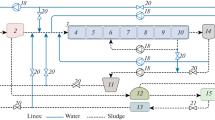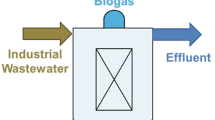Abstract
The study provided a critical appraisal of the extended aeration process as a single-sludge system for nitrogen removal, emphasizing its inherent deficiencies. For this purpose, the system was designed first using the prescribed procedure in the German practice, ATV A-131. The design used the basic data reported in different studies related to conventional characterization and chemical oxygen demand (COD) fractionation defining the biodegradation characteristics of domestic wastewater. A critical appraisal of the design was made with emphasis on the fate of biodegradable COD and oxidized nitrogen in the anoxic phase by process modeling and evaluation. The results obtained were evaluated using basic stoichiometry and mass balance for major nitrogen fractions. The A-131 design based on a total sludge age of 20 days defined a system with a hydraulic residence time of 1.2 days where half of the volume was operated under anoxic conditions; the effluent nitrate concentration was reduced to 8.3 mg N/L with an internal recycle (nitrate) ratio of 4.9. Model evaluation of the prescribed design indicated that oxidized nitrogen was totally consumed within the first 25–30 % portion of the anoxic volume. The remaining volume was forced to operate under anaerobic conditions, where no appreciable endogenous decay would occur. ATV A-131 procedure, relying on empirical coefficients and expressions, was neither consistent with process stoichiometry nor justifiable by modeling. Evaluations based on modeling and process stoichiometry revealed significant inherent weaknesses of extended aeration for providing a sustainable basis for nitrogen removal.




Similar content being viewed by others
References
ATV-131 Dimensioning of single stage activated sludge plants (2000) GFA Publishing Company of ATV-DVWK Water, Wastewater and Waste, Hennef Germany. ISBN: 3-935669-82-8.
Avcıoğlu, E., Orhon, D., & Sözen, S. (1998). A new method for the assessment of heterotrophic endogenous respiration rate under aerobic and anoxic conditions. Water Science and Technology, 38(8-9), 95–103.
Dold, D. L., & Marais, G. V. R. (1986). Evaluation of the general activated sludge model proposed by the IAWPRC Task Group. Water Science and Technology, 18(6), 63–89.
Gikas, P. (2014). Electrical energy production from biosolids: a comparative study between anaerobic digestion and ultra-high-temperature gasification. Environmental Technology, 35(17), 2140–2146.
Grady, C. P. L., Jr., Daigger, G. T., & Lim, H. C. (1999). Biological wastewater treatment. New York: Marcel Dekker Inc.
Henze, M. (1992). Characterization of wastewater for modelling of activated sludge processes. Water Science and Technology, 25(6), 1–15.
Henze M., Grady C. P. L. Jr., Gujer W., Marais G.v.R., Matsuo T. (1987). Activated sludge model No.1, IAWPRC Science and Technical Report No. 1 IAWPRC London UK.
Henze, M., Gujer, W., Mino, T., & van Loosdrecht, M. C. M. (2000). Activated sludge models: ASM1, ASM2, ASM2d and ASM3, Scientific and Technical Report No: 9. London: IWA Publishing. UK 2000.
Hocaoglu, M. S., Atasoy, E., Baban, A., Insel, G., & Orhon, D. (2013). Nitrogen removal performance of intermittently aerated membrane bioreactor treating black water. Environmental Technology, 34(19), 2717–2725.
Insel, G., Guder, B., Gunes, G., & Ubay, C. E. (2012). Are all design prescriptions suitable for any BNR plant? Water Science and Technology, 66(2), 328–335.
Kristensen, G. H., Jorgensen, P. E., & Henze, M. (1992). Characterization of functional microorganism groups and substrate in activated sludge and wastewater by AUR, NUR and OUR. Water Science and Technology, 25(6), 43–57.
McCarty, P. L., & Brodersen, C. F. (1962). Theory of extended aeration activated sludge. Journal of the Water Pollution Control Federation, 34, 1095–1103.
McClintock, S. A., Pattarkine, V. M., & Randall, C. W. (1992). Comparison of yields and decay rates for a biological nutrient removal process and a conventional activated sludge process. Water Science and Technology, 26(9-11), 2195–2198.
MEUP (2014). Ministry of Environment and Urban Planning. Department of EU Investments (Personal communication).
Middlebrooks, E. J., & Gardland, C. F. (1968). Kinetics of model and field extended-aeration wastewater treatment units. Journal of the Water Pollution Control Federation, 40, 586–612.
Middlebrooks, E. J., & Jenkins, D. (1969). Kinetics and effluent quality in extended aeration. Water Research, 3, 39–46.
Morris G. L. (1963). Extended aeration plants and intermittent water courses, Public Health Service Publ No 999-WP 8
NSF (1968). National Sanitation Foundation, Package Plant Criteria I. Extended Aeration Wastewater Treatment Units, Ann Arbor
Orhon, D. (2015). Evolution of the activated sludge process: The first 50 years. Journal of Chemical Technology and Biotechnology, 90, 608–640.
Orhon, D., Artan, N., & Cimşit, Y. (1989). The concept of soluble residual product formation in the modelling of activated sludge. Water Science and Technology, 18, 21–33.
Orhon, D., Sözen, S., & Ubay, E. (1994). Assessment of nitrification- denitrification potential of Istanbul domestic wastewaters. Water Science and Technology, 30, 21–30.
Orhon, D., Sözen, S., & Artan, N. (1996). The effect of heterotrophic yield on the assessment of the correction factor for anoxic growth. Water Science and Technology, 34, 67–74.
Orhon, D., Okutman, D., & Insel, G. (2002). Characterization and biodegradation of settleable organic matter for domestic wastewater. Water SA, 28(3), 299–305.
Orhon, D., Babuna, F. G., & Karahan, O. (2009). Industrial wastewater treatment by activated sludge. London: IWA Publishing.
Ozdemir, S., Çokgör, E. U., & Orhon, D. (2014). Modeling the fate of particulate components in aerobic sludge stabilization—performance limitations. Bioresource Technology, 164, 315–322.
Reichert P., Ruchti J., Simon W. (1998). AQUASIM 2.0, Swiss Federal Institute for Environmental Science and Technology (EAWAG), CH-8600 Duebendorf, Switzerland.
Sawyer, C. N. (1965). Milestones in the development of the activated sludge process. Journal of Water Pollution Control Federation, 37, 151–162.
Siegrist, H., Brunner, I., Koch, G., Phan, L. C., & Le, V. C. (1999). Reduction of biomass decay rate under anoxic and anaerobic conditions. Water Science and Technology, 39(1), 129–137.
Sozen, S., Cokgor, E. U., Orhon, D., & Henze, M. (1998). Respirometric analysis of activated sludge behaviour—II. Heterotrophic growth under aerobic and anoxic conditions. Water Research, 32(2), 476–488.
Sozen, S., Artan, N., Orhon, D., & Avcıoğlu, E. (2002). Assessment of the denitrification. Water Science and Technology, 46, 237–246.
Tas, D. O., Karahan, O., Insel, G., Ovez, S., Orhon, D., & Spanjers, H. (2009). Biodegradability and denitrification potential of settleable chemical oxygen demand in domestic wastewater. Water Environment Research, 81, 715–727.
van Haandel, A. C., Ekama, G. A., & Marais, G. V. R. (1981). The activated sludge process —3: single sludge denitrification. Water Research, 15, 1135–1152.
WEF Manual of Practice (2009). Energy conservation in water and wastewater treatment facilities. ISBN: 978-0-07-166794-4 Alexandria USA.
Author information
Authors and Affiliations
Corresponding author
Rights and permissions
About this article
Cite this article
Insel, G., Cokgor, E., Tas, D.O. et al. Impact of the Anoxic Volume Ratio on the Dynamics of Biological Nitrogen Removal Under Extended Aeration Conditions. Water Air Soil Pollut 226, 405 (2015). https://doi.org/10.1007/s11270-015-2634-9
Received:
Accepted:
Published:
DOI: https://doi.org/10.1007/s11270-015-2634-9




